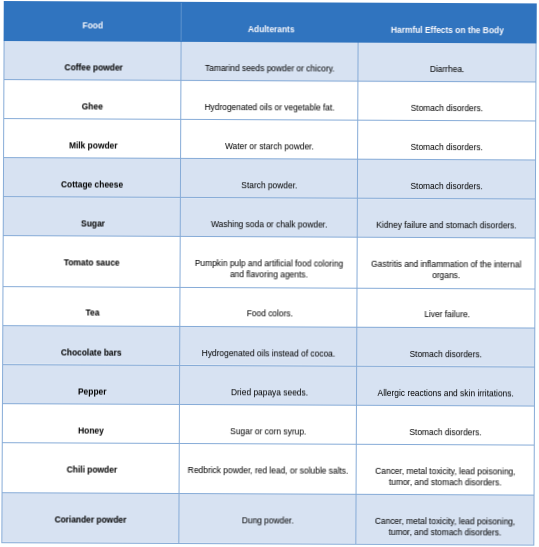What Is Food Adulteration?
Food adulteration is adulterating (degrading) or contaminating food with certain materials, which are collectively called adulterants (a substance that lowers the quality of food). It is most commonly done in developing countries. According to the Food Safety and Standards Authority of India (FSSAI), the commonly adulterated foods are milk and milk products, pulses, coffee, edible oils, tea, cereals, baking powder, vinegar, chili powder sauces, etc. When the food does not meet the legal standard fixed by the Government, it is considered a legal offense.
What Are the Types of Adulteration?
The adulterants can be classified as:
-
Intentional Adulterants: The harmful substance is added intentionally to food products for economic purposes.
-
Incidental Adulterants: It occurs due to metallic contamination with arsenic, lead, or mercury. Pests like insects and rodents can enter the food products and mix the larva or excreta produced incidentally.
-
Metallic Adulterants: Tin from cans and lead from water can be referred to as metallic adulterants. When stored in cans, foods can be mixed with tin and cause harmful effects to the body.
Is It Good to Eat Adulterated Food?
Eating adulterated food is highly toxic to the body, leading to various health problems. Poor quality products are added to the food products for economic and technical benefits. When added to the food, adulterants can make it unsafe or sub-standard for anyone to consume. Adulteration is considered one of the man-made hazards that can be very harmful.
Some of the foods that can be adulterated and their harmful effects on the body are:

What Are the Effects of Food Adulteration on Children’s Health?
Well, food adulteration affects a large arena of society, especially children and teens who, due to lack of awareness, consume adulterated foods like soft drinks with added artificial colors, which may lead to various harmful effects on the gut in the long run. An easy way to detect adulteration in soft drinks at home is by heating the particular soft drink for forty-five minutes. One would observe something that resembles coal tar, which is sticky.
What Are the Long-Term Harmful Effects of Consuming Adulterated Food in the Long Run by Children?
Impaired Gut Health:
Recently, we read in the news about a certain brand of instant noodles adulterated with lead, causing several gastric issues like worms and impaired flora in the gut. The media focused on the particular ingredient was monosodium glutamate (MSG), which was falsely claimed. Long-term consumption of processed foods adulterated with constituents like lead would definitely lead to impaired gut health. Even apples these days are coated with wax. So, do be careful while selecting apples. Peel the apple skin with a scale. If you see a rubbery waxy coating coming out, it means that the apple is coated with wax to increase its shelf life, which may have harmful effects on your gut. Foods like coffee, milk products, tea, tomato sauces, edible oils, honey, chocolates, curry powders, when adulterated with some adulterants, can cause stomach disorders. Therefore, it is advisable to look for food quality before consuming it.
Degraded Mental Health:
These days, many green vegetables are adulterated with various food dyes, which could harm your nervous systems, like lack of concentration in kids and forgetfulness and convulsions. The easy way to detect adulteration in green leafy vegetables is by dipping the greens in hot paraffin oil. If you see the greens leaving some color, it means that it is adulterated with dyes which may have a harmful effect on your kid's mental health. Parents need to take some household measures to ensure the good health of their children.
Impaired Respiratory Health:
The addition of plastic to food has become very common these days, but did you know that it has a very harmful effect on your respiratory system? Kids these days consume processed chips, but sadly, some contain plastic, which could also lead to issues like asthma in the long run. The method to detect this adulteration is by simply burning it. Ashes are produced, which proves that it is adulterated with plastic which is harmful not only for the respiratory health and gut but also for the nervous system.
Toxicity in the Body:
In the long run, consuming adulterated food can lead to toxicity, cancer, infertility, brain damage, body paralysis, and finally, death in extreme cases.
Fertility Issues:
Children consuming adulterated food for an extended period can have fertility issues or problems in conceiving in their later life. It can even lead to abortion in pregnant women.
Conclusion:
Food adulteration is a common problem all over the world. Therefore, it is essential to understand and identify the types of food adulteration to avoid any harmful effects on our bodies. After buying any food products, look for the list of ingredients added to it, manufacturing date, expiry date, and the FSSAI standardization.










